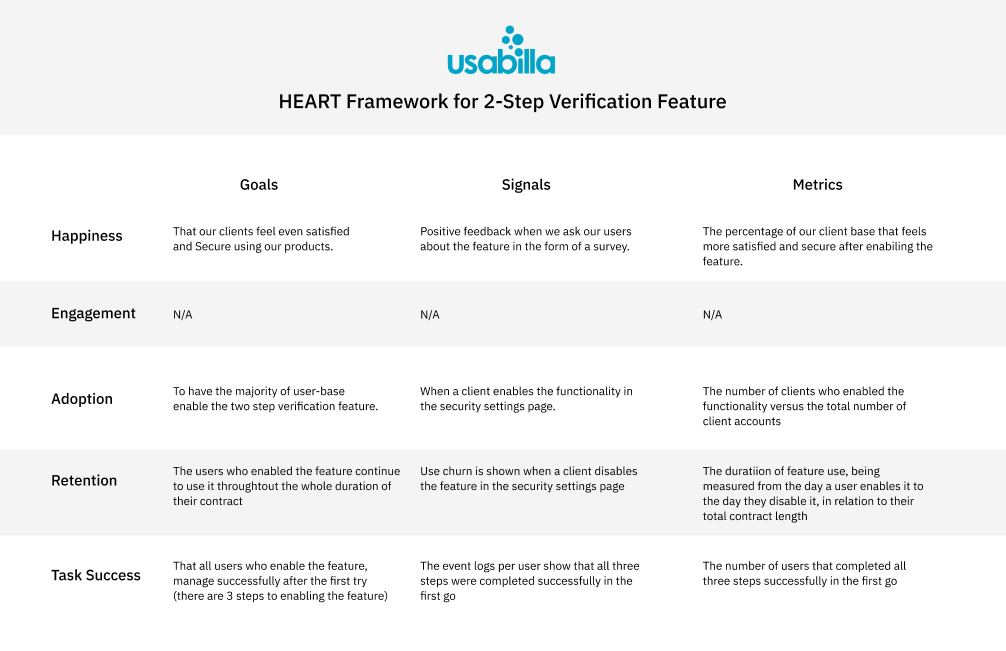Google’s HEART theory, know all about it for better SEO
May 2, 2021 | Read Time : 3 mins
Table of Contents
Conducting research without a framework can possess difficult challenges leading to a lack of collected information. The same problem was faced by Google when they couldn’t comprehend how to get results that are both data-driven and user-centred.
The research team with Kerry Rodden, Hilary Hutchinson, and Xin Fu designed the “HEART theory’.
What is HEART theory?
Happiness – Satisfaction, NPS (net promoter score)
Engagement – User activity
Adoption – New users, Usage
Retention – % of active users, Unit of time
Task Success – Time, completed the task, errors
This theory/framework was designed to meet UX metrics results from extensive research.
Kerry Rodden mentions these can be applied to any level – from one specific feature to the whole product.
Here the research team also has an option to choose which category to focus on. For example, Usabilla when using heart-framework for a 2-step verification process used in happiness, adoption, retention, and task success.
In order to determine the success of the features they determined the following goals:

The idea is to break a fuzzy goal, and achieve it systematically and get authentic results.
The framework helps to measure UX effectively:
Let’s deep dive into the explanation of the HEART framework:
H= Happiness
The simplest measure which helps find the difficult metric; the User’s satisfaction with the product. This category helps in finding out user satisfaction via surveys and interviews.
The importance here is to figure out the why and user’s understanding of how do they feel about the product.
E= Engagement
This measure helps in finding how the user is interacting with the product. How do they feel about the product and their experience with the product?
The importance here is to help in finding out the pain points of the users while interacting with the product.
A= Adoption
Metric helps find how many new people are signing up or choosing the product. This feature helps track the number of users visiting and further converting into users.
The importance here is in knowing the path of a new user, and how and why they are choosing and converting into full-time users.
R= Retention
This measures the rate at which existing users are returning to the product, and keeping the users for x amount of time.
The importance here is in helping track the time of existing users using the product, a good reflection of the site’s performance over the period of time.
T= Task Success
Breaking components into smaller tasks that help find user experience metrics. This feature encompasses behavioural metrics such as efficiency, effectiveness, and error rate.
The importance here is in finding an optimal path for a particular task helps in a measure how closely the user is following it.
How we can use Google’s HEART theory for better SEO?
Initially, it may seem incidental, but the UX of a website has a lot to do with SEO. Gone are the days when the search engines would show websites that have maximum keywords, the search engines are now focused on providing a better solution to users’ needs. A list of websites through which users can navigate easily has the right content for better engagement.
How UX helps your website?
User Experience is basically a user interacting with a system. It also includes mobile applications, websites, and any form of human/ device interaction.
If the system (website, mobile) has good UX it helps the user achieve their goals easily.
The framework helps in finding out micro and macro measurements to help determine the product’s user journey.
1. Pick a category that you need to focus on, it can also just open a category or all the four categories. If your website has guided videos, blogs you would want to track how people are engaging with it. You also want to keep track of changes that are required according to user behaviour.2. Now if you look at the Usabilla framework the topmost row has the following options:
– Goals
– Signals
– Metrics
After picking up the category now is the time to add signals and goals you wish to achieve. Here the balance of user and business goals is important.
3. Pick a category that you need to focus on, it can also just open a category or all the four categories. If your website has guided videos, blogs you would want to track how people are engaging with it. You also want to keep track of changes that are required according to user behaviour.
The idea of heart theory is to help designers and researchers find effective results. Whether it’s for a small company or a large project like one of Google’s, the HEART framework can be applicable to the majority of UX researches.






